The corrugated steel silo is common in the bulk storage of grains due to its large capacity & high mechanization degree.
The storage & transportation of bulk grain is the grain circulation trend in the future, and steel grain silos will play a greater role.
The 1st photo shows the first-phase bulk grain storage metal silo of the Rizhao Port, there are 12 metal silos and a single grain storage silo capacity is 12000T, and the entire system started to run on July 12, 2005;
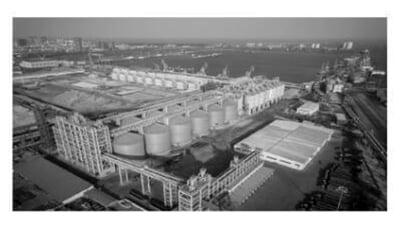
1
And the 2nd photo below shows the third-phase expansion project of Rizhao Port’s bulk grain storage silo, there are 24 metal grain silos, 1 single grain storage silo capacity is 10,000T, and the total capacity is 240,000T.
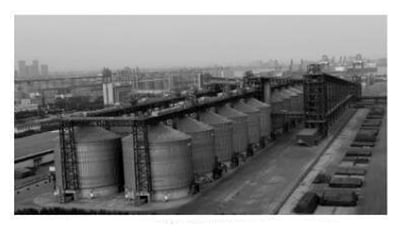
2
Around these new grain storage bin groups, the port constructed loading & unloading conveyor lines, metering systems, and train & automobile loading systems.
The bulk grain storage includes the following steps:
- Bulk Grain Loading
- Buck Grain Unloading
- Train Loading
- Recycling
Corrugated Steel Silo Usage & Management for Bulk Grain Storage
Composition of Steel Grain Silo
The first-phase bulk grain silo is a corrugated grain bin, it has 2 axial fans & 16 vents at the top, and 4 centrifugal fans at the bottom, it equips with air ductwork & ventilation network, and a sweep auger lies in the silo.
There is 1 electric slide gate (800mm x 800mm) on the roof & 7 slide gates (700mmx700m) at the bottom, 7 bottom slide gates are symmetrical, and the whole grain silo adopts the CGS grain monitor & control system.
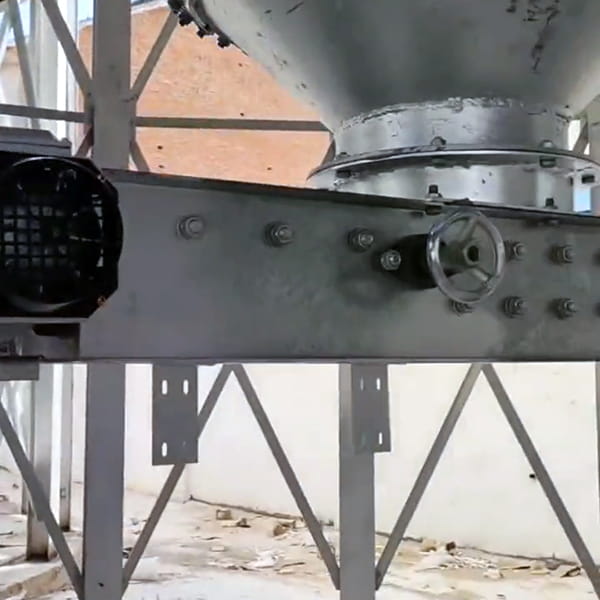
Slide Gate
The third-phase metal silo for bulk grains is corrugated steel flat bottom silo, its roof sheets are all double-overlapped & have excellent sealing performance.
In each group of grain storage silos, the center axis distance between the two rows is 31m, and each fan can efficiently provide the air volume & pressure for 24h.
In the case of full loading, even if the axial fan on the roof doesn’t work, it can provide sufficient air pressure & volume to blow through the grain pile.
How to Use Steel Grain Bin
Before Loading
Inspect all parts of the steel silo in detail, the inspection includes:
- The open & close status of the feed inlet on the rooftop, inspection door on the silo wall;
- Whether the temperature measuring cable is fastened;
- The position & cable plug of the sweep auger;
- Whether the iron floor flange of the ventilation network is tilted;
- The manual slide gate (electric slide gate) switch status at the bottom of the silo;
- Whether there is any debris in the silo.
After the inspection, report to the central control room.
Generally, please don’t enter the silo, if you must enter the steel grain silo, turn off all power supplies, fasten safety ropes & belts, and arrange for someone to wait outside the steel grain bin for assistance.
Avoid entering the center of the metal silo, and wear breathing equipment or dust masks correctly.
Loading Trial
When the silo is in use, it is necessary to carry out a material loading trial, please refer to the figure below for the trial standard.
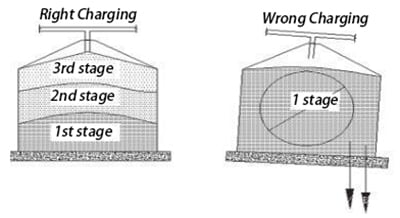
If dividing the loading trial into 4 stages, the loading ratio of each stage is 50%, 20%, 20%, and 10%;
If dividing the loading trial into 3 stages, the loading ratio of each stage is 60%, 30%, and 10%.
After each stage of loading is over, rest the steel grain silo for a certain period of time, the resting time for the first 2 stages must be ≥1 month, and for the final stage, the resting time must be ≥2 months.
Multi-stage loading reduces the uneven settlement of the foundation bottom.
Loading
Before loading, confirm the target metal silo no., after closing the bottom slide gate & access door, open the rooftop slide gate, then turn on the feeding equipment.
The material enters the grain storage silo correctly from the top slide gate.
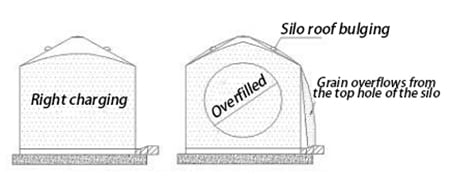
During loading, the material movement direction is basically vertical, thus the material doesn’t deviate to both sides.
If the material reaches the maximum level, the alarm sounds, and the system automatically stops, preventing the grain bin from overflowing.
Once the grain loading is beyond the storage capacity, it may cause the roof to expand outward & lead to damage.
When there is too much grain in the silo, opening the manhole at the top will cause grain overflow.
Storage
During the material storage period, test the materials regularly, and pay attention to the temperature in the silo timely.
Due to the steel silo’s good thermal conductivity, the outside temperature affects the grain close to the steel wall, and the temperature in the silo easily rises in summer.
If the temperature is too high, material hardening & coking will occur, then ventilating the metal grain silo is essential.
When the temperature in the silo can’t drop, take out all the material.
Unloading
Incorrect unloading will cause damage to the metal grain silo’s overall structure, leading to silo collapsing.
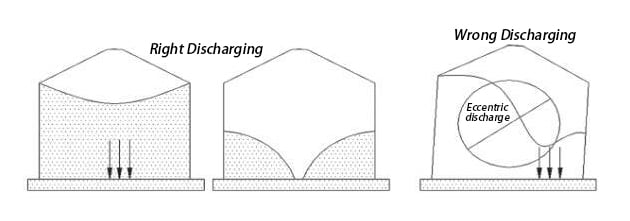
Unloading must begin from the central outlet.
After the material unloading from the central outlet finishes, then open the non-central outlet. During the unloading process from the center outlet, the non-central outlets must be closed.
When unloading, first turn on the conveyor under the metal grain silo, then open the slide gate under the metal grain silo.
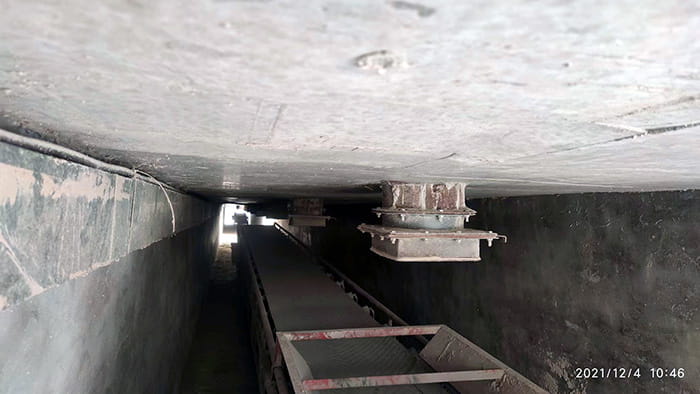
According to the outgoing delivery volume, determine the manual slide gate’s opening size. If the opening size is too large, the conveyor under the silo may be blocked.
If it is a multi-point unloading, after finishing the central outlet unloading, then open two symmetrical outlets at the same time, ensuring their flow rate is the same.
Natural Unload Stage
When unloading the material, first start a standard unloading process, open the electrical slide gate at the bottom of the silo as needed, then gradually increase the manual slide gate’s opening size.
If the opening size is too large at the beginning, it will cause a blockage of the belt. In the case of a large amount of material, first, open the third group of outlets for unloading.
If the flow rate doesn’t meet the requirements, open the 2nd & 1st group in turn, and finally open the central outlet.
Clearance Stage
The 1st, 2nd, and 3rd groups of outlets must be closed before starting the sweep auger, only the central outlet is open when clearing.
As the sweep auger can’t clear completely, the clearing personnel must stand behind the sweep auger’s moving direction, wear a safety belt, and use a steel lift & a large broom to clear the metal grain bin.
The sweep auger operator should keep in touch with the personnel in the steel grain bin, and ensure that the sweep auger is not overloaded & does not slip, which can improve the clearance efficiency.
The clearance flow of the sweep auger is 250t/h.
Metal Silo Inspection & Processing after Clearance
Please refer to the following inspection & processing list.
- Close all the valves of the metal silo;
- Collect the cable plug of the sweep auger;
- Fasten the temperature measurement cable in the silo;
- Check whether the ventilation network & iron floor flange is warped & damaged;
- Check for debris;
- Close the access door & manhole.
 SiroSilo
SiroSilo